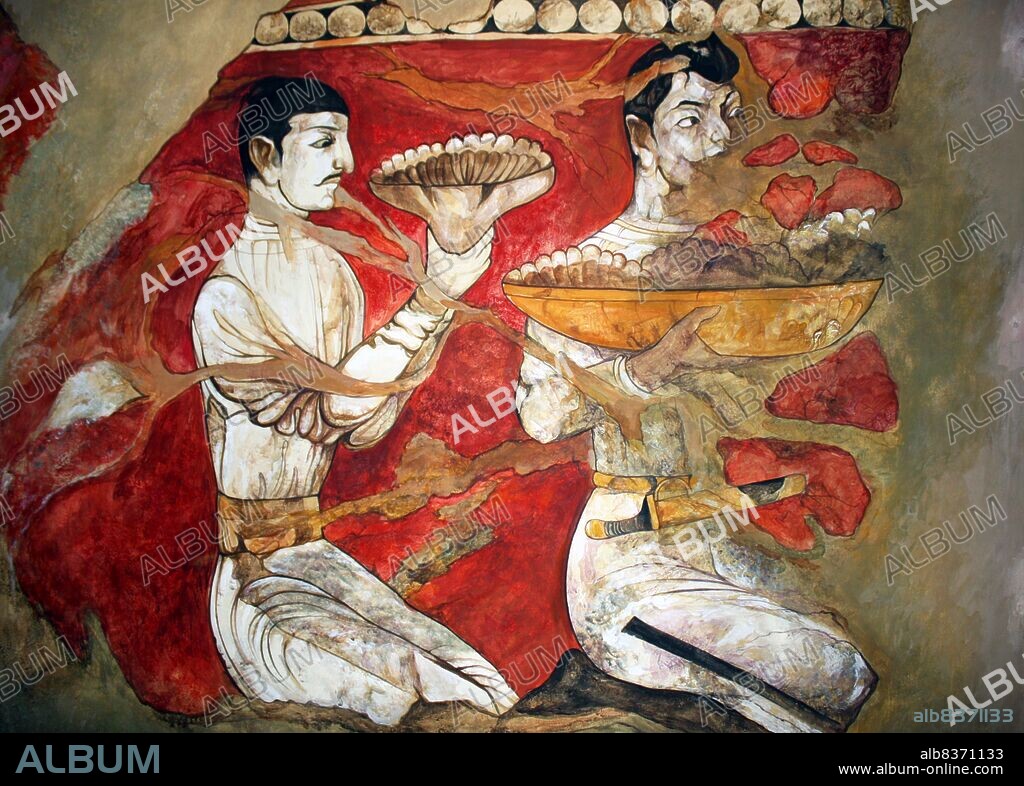alb8371133
Tajikistan: Men bearing offerings. Restored painting of a mural from the Buddhist temple of Ajina Tepa,7th-8th century CE, Dushanbe National Museum

|
Zu einem anderen Lightbox hinzufügen |
|
Zu einem anderen Lightbox hinzufügen |



Haben Sie bereits ein Konto? Anmelden
Sie haben kein Konto? Registrieren
Dieses Bild kaufen.
Nutzung auswählen:

Titel:
Tajikistan: Men bearing offerings. Restored painting of a mural from the Buddhist temple of Ajina Tepa,7th-8th century CE, Dushanbe National Museum
Untertitel:
Siehe automatische Übersetzung
The Buddhist cloister of Ajina-Tepa is situated 12 km east of the city of Kurgan-Tiube, Tajikistan. According to archeologists, the cloister was built in the 7th - 8th centuries CE. Ajina-Tepa was a name given by the locals to the hill under which the ruins of the cloister lay hidden. The name translates from Tajik as 'Devil's Hill', as it is believed that the place is the abode of evil spirits.
. The excavations of the hill were started in 1959 by Soviet archaeologists. The cloister had 2-m thick walls, built out of massive blocks of adobe, and consisted of two rectangular courtyards, surrounded by stupas, corridors and cells. More than 600 works of art, found during the 15 years of excavation, indicate how rich the original decoration of the temple was.
. The excavations of the hill were started in 1959 by Soviet archaeologists. The cloister had 2-m thick walls, built out of massive blocks of adobe, and consisted of two rectangular courtyards, surrounded by stupas, corridors and cells. More than 600 works of art, found during the 15 years of excavation, indicate how rich the original decoration of the temple was.
Bildnachweis:
Album / Universal Images Group / Pictures From History
Freigaben (Releases):
Bildgröße:
5100 x 3649 px | 53.2 MB
Druckgröße:
43.2 x 30.9 cm | 17.0 x 12.2 in (300 dpi)
Schlüsselwörter:
ANTIKE • ASIEN • ASIEN, KONTINENT • BUDDHISMUS • BUDDHISTISCH • FRESCO • FRESKE • FRESKO • GEMAELDE • KONTINENT, ASIEN • KUNST • MALEREI • MAUERGEMÄLDE • RELIGION • SOGDIAN • TECHNIK: FRESKO • TECHNIK: WANDMALEREI • TEMPEL • WANDBILD • WANDMALEREI • WANDZEICHNUNG
 Pinterest
Pinterest Twitter
Twitter Facebook
Facebook Link kopieren
Link kopieren Email
Email
